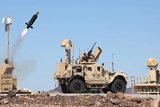US Army to field first human-machine platoon in two years
A human-machine integration experiment underway at Fort Irwin, California. (Photo: US Army)
The US Army Rapid Capabilities and Critical Technologies Office (RCCTO) plans to field the service’s first human-machine platoon in two years (FY2027) as it has been progressing with the incorporation of autonomous capabilities into its inventory.
Aimed at increasing the safety of troops while reducing their cognitive and physical burden, the branch’s human-machine integration formations (HMIF) will include the deployment of ground and air unmanned solutions in armoured and infantry configurations.
“HMF will bring robotic systems into formations with the goal of having machines, not soldiers, make first contact with the enemy,” Lt Col Jonathan Judy, the military deputy of human
Already have an account? Log in
Want to keep reading this article?
More from Land Warfare
-
![HIMARS arrive in Hawaii as first multinational launch in Australia takes place]()
HIMARS arrive in Hawaii as first multinational launch in Australia takes place
The M142 High Mobility Artillery Rocket System (HIMARS) launcher is in high demand with Lockheed Martin doubling speed of manufacture since Russia’s invasion of Ukraine. As orders are racked up in Europe, the Indo-Pacific region is seeing the increasing presence of the system.
-
![Ireland’s Reamda develops new version of Riddler UGV]()
Ireland’s Reamda develops new version of Riddler UGV
The company's Riddler uncrewed ground vehicle (UGV) is designed to be small and light to allow easy deployment and the ability to access smaller areas such as bus or train aisles.
-
![Spain to invest billions of dollars on howitzers and other vehicles as it looks to select new tanks]()
Spain to invest billions of dollars on howitzers and other vehicles as it looks to select new tanks
The Spanish Government has outlined plans to purchase communications and cybersecurity capabilities but most notably amphibious combat vehicles, self-propelled howitzers (SPHs), bridge-laying vehicles and an effort to replace its tanks from 2040.
-
![What does Germany’s new tank joint venture mean for MGCS?]()
What does Germany’s new tank joint venture mean for MGCS?
Germany is Europe’s leading country for tank manufacture and until this month was committed to the Franco-German Main Ground Combat System (MGCS) which included tanks and other vehicles. Earlier this month, Germany and other European countries set up the Main ARmoured Tank of Europe (MARTE) project casting a shadow over the MGCS.
-
![CAVS rolls on as Denmark orders 129 vehicles]()
CAVS rolls on as Denmark orders 129 vehicles
Denmark signed the Technical Arrangement for the multinational Common Armoured Vehicle System (CAVS) in April this year. The order means the country will receive its first vehicle this year.
























